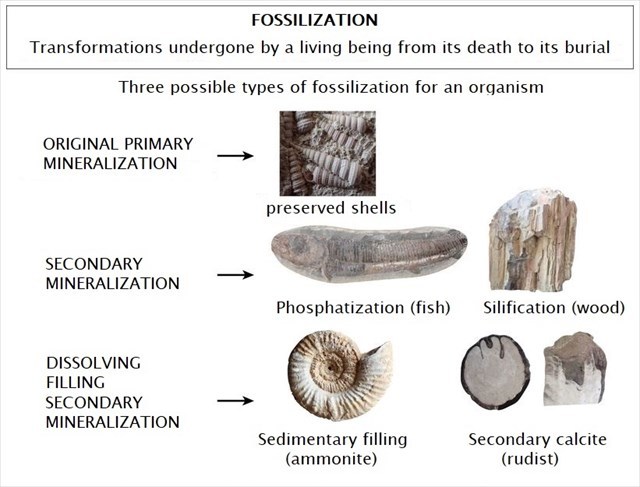Dans la Champagne, sur le territoire viticole et au cœur du Parc Naturel Régional de la Montagne de Reims s’inscrit une formation géologique très particulière appelée tuffeau de Damery. Le sous-sol de ce tuffeau abrite un gisement fossilifère connu dès le XIXème siècle par les géologues et paléontologues.
Cette formation de sables calcaires a conservé une diversité de faune marine remarquablement bien conservée datée du Lutétien moyen, soit il y a 45 millions d’années. Une faune constituée de mollusques impressionnants, à l’image du Campanile giganteum, un escargot marin dont la coquille peut atteindre jusqu’à 60cm de long. C’est notamment pour ce fossile que le tuffeau a attiré de nombreux chercheurs, mais l’on y trouve une abondance d’autres espèces.

La formation des fossiles ne peut avoir lieu que dans des roches sédimentaires.
Un animal meurt, tombe au sol et ses parties molles sont dégradées. Les parties dures (coquilles, os, graine, ...) sont recouvertes par les sédiments qui s’accumulent au fond du bassin sédimentaire (mer, océan, lac, étang,... il faut de l’eau !).
Avec le temps et la compaction liée au poids de la colonne d’eau qui est sur les sédiments, l’ensemble durcit et devient une roche sédimentaire. La trace de l’être vivant est conservée dans les sédiments.
Avec les mouvements tectoniques, les roches sédimentaires finissent par affleurer et avec l’érosion, les fossiles peuvent être dégagés.
 This Earthcache is not freely accessible, to make it you must take part in a guided tour of the
This Earthcache is not freely accessible, to make it you must take part in a guided tour of the
In Champagne, on the wine-growing territory and in the heart of the Regional Natural Park of the Montagne de Reims, there is a very special geological formation called the tuffeau de Damery. The basement of this tuffeau shelters a fossiliferous deposit known since the 19th century by geologists and paleontologists.
This limestone sand formation has preserved a remarkably well-preserved diversity of marine fauna dating from the Middle Lutetian, i.e. 45 million years ago. A fauna made up of impressive molluscs, like the Campanile giganteum, a marine snail whose shell can reach up to 60cm in length. It is in particular for this fossil that the tuffeau has attracted many researchers, but there is an abundance of other species.
The formation of fossils can only take place in sedimentary rocks.
An animal dies, falls to the ground and its soft parts are degraded. The hard parts (shells, bones, seeds, etc.) are covered by sediments which accumulate at the bottom of the sedimentary basin (sea, ocean, lake, pond, etc. water is needed!).
Over time and the compaction linked to the weight of the column of water which is on the sediments, the whole hardens and becomes a sedimentary rock. The trace of the living being is preserved in the sediments.
With tectonic movements, sedimentary rocks end up outcropping and with erosion, fossils can be unearthed.

Questions pour valider cette earthcache :
D'après vos observations et à l'aide du descriptif :
Questions to validate this earthcache:
Based on your observations and using the description :
Question 0
Joindre à votre log (PAS à vos réponses) une photo de vous ou une partie de vous avec votre GPS, votre GC perso ou tout autre objet de geocaching avec un fossile de Campanile géant dans la galerie souterraine.
Les simples photos sans éléments personnels ou capture d'écran de votre position ne permettent de valider cette condition de log.
Cette tâche est obligatoire et autorisée par les guidelines mises à jour en juin 2019.
Attach to your log (NOT to your answers) a photo of you or a part of you with your GPS, your personal GC or any other geocaching object with a giant Campanile fossil in the underground gallery.
The simple photos without a personnal item or screenshot of your position do not validate this log condition.
This task is mandatory and allowed by the guidelines updated in june 2019.
Question 1
Quel élément est nécessaire au processus de fossilisation ?
Which element is necessary for the fossilization process ?
Question 2
Au niveau de la plateforme surplombant le puits, vous pouvez observer un fossile dans la paroi sous la zone bleue.
Décrivez le fossile et à l'aide de clé d'identification, déterminez de quel type de fossile il s'agit.
At the level of the platform overhanging the well, you can observe a fossil in the wall under the blue zone.
Describe the fossil and using the identification key (in french), determine what type of fossil it is.
Question 3
Quel type de fossilisation présentent les fossiles de Campaniles que l'on peut observer sur ce site ? (minéralisation primaire ou secondaire, remplissage ?)
What type of fossilization do the Campaniles fossils that can be observed on this site show ? (primary or secondary mineralization, filling ?)
Envoyez-moi vos propositions de réponses soit via mon profil, soit via la messagerie geocaching.com (Message Center) PUIS loguez cette cache "Found it", je vous contacterai en cas de problème.
Assurez vous de répondre à TOUTES les questions ! La condition principale pour loguer une Earthcache étant de répondre aux questions posées dans le descriptif, tout log "Found it" enregistré sans envoi préalable de vos propositions de réponses sera supprimé. Il en sera de même pour les logs enregistrés sans la photo requise.
Send me your proposals for answers either via my profile or via the geocaching.com messaging (Message Center) THEN log this cache "Found it", I will contact you in case of problem.
Make sure to answer ALL questions ! The main condition to log an Earthcache is to answer the questions asked in the description, any log "Found it" registered without prior submission of your proposals of answers will be deleted. It will be the same for logs saved without the required photo.